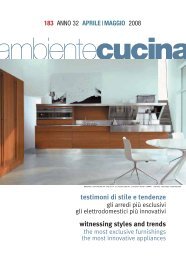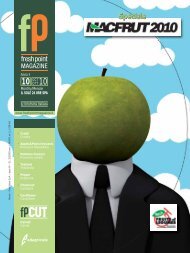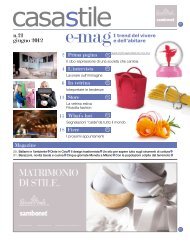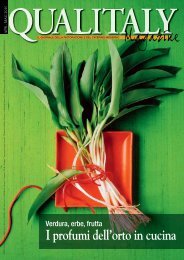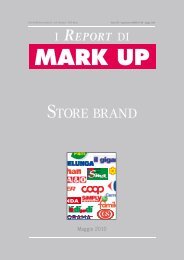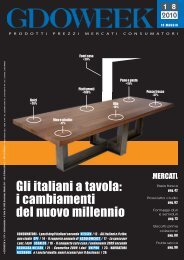Fresh Point Magazine - B2B24 - Il Sole 24 Ore
Fresh Point Magazine - B2B24 - Il Sole 24 Ore
Fresh Point Magazine - B2B24 - Il Sole 24 Ore
You also want an ePaper? Increase the reach of your titles
YUMPU automatically turns print PDFs into web optimized ePapers that Google loves.
market/Argentina<br />
mercati/Argentina<br />
Argentina, where harvests<br />
depend on whims of El Niño<br />
Argentina, quando il raccolto<br />
dipende dai capricci del Niño<br />
Miguel Angel Buenos Aires<br />
Floods, downpours, and low temperatures besetting produce season, especially<br />
for apple and pear. Even small sizes no barrier to exports<br />
Alluvioni, piogge e temperature basse determinano l’andamento delle produzione di<br />
ortofrutta, in particolare di pere e mele. E nell’export contano anche i piccoli calibri<br />
Argentina’s weather is under the thumb of El Niño,<br />
one of the world’s best known climate patterns<br />
because it can unleash a spate of torrential rains that<br />
cause destructive floods. It was expected to reach its<br />
greatest intensity over the first six months of this year<br />
and gradually fade out by July. Rains and cold temperatures<br />
in spring 2009 disrupted the development<br />
of fruit and vegetable crops, delaying bloom and harvest<br />
and reducing fruit size in Gala apple and Williams<br />
pear. It’s also worth noting that it also had a beneficial<br />
effect or two since it enhanced the red colour in apple<br />
and improved the storability of all fruit crops.<br />
Argentina’s main apple and pear growing districts are<br />
in Río Negro, Neuquén and Mendoza provinces, in<br />
that order of importance. Given that the climate over<br />
the last few decades has not been favourable to apple<br />
growing, there has been a shift to pear. The leading<br />
cultivars in both species are Williams for pear and<br />
Red Delicious for apple.<br />
Industry experts and observers expect to see an overall<br />
12% slide in the 2010 pear crop on the year (table<br />
1), with the most pronounced downturn being the 19%<br />
in Williams, followed by the attenuated 12% slide for<br />
the red cultivars Red Bartlett and Red Danjou and the<br />
10% for Packham´s Triumph. The Anjou and Kaiser<br />
crops are projected to be up on the year whereas Abbé<br />
Fetel is forecast to have a volume comparable to the<br />
crop 2009. The industry also expects that 50% of the<br />
Williams crop will be in the small 65-55mm size range.<br />
The slide expected in apple will be about 10% on the<br />
year. The reason why the Red Delicious crop is<br />
expected to be off by as much as 16% is that this<br />
variety and its suite of clones are marked by alternateyear<br />
bearing to begin with, a phenomenon that is cou-<br />
22 <strong>Fresh</strong> <strong>Point</strong> <strong>Magazine</strong> n.4 – april/aprile 2010<br />
<strong>Il</strong> clima dell’Argentina è dominato dal Niño, un ben noto fenomeno<br />
meteorologico che causa l'aumento della piovosità<br />
con alluvioni anche distruttive. Per quest’anno, l'intensità<br />
maggiore era attesa nel primo trimestre, col fenomeno che via<br />
via si sarebbe attenuato nei mesi sucecssivi fino a scomparire<br />
in luglio. Nella primavera del 2009, le pioggie e le temperature<br />
fredde avevano colpito l'orticoltura, ritardando la fioritura e la<br />
raccolta con impatti negativi nel calibro, soprattutto per la pera<br />
Wiliams e la mela Gala, con frutti più piccoli. Qualche effetto<br />
era invece stato di segno positivo come, ad esempio, il colore<br />
più marcatamente rosso delle mele e una migliore condizione<br />
per la conservazione di tutta la frutta.<br />
Le zone principali di produzione di mele e pere sono le<br />
Province di Río Negro e Neuquén, seguite per importanza<br />
da quella di Mendoza. Poiché nelle ultime decadi il<br />
clima non ha favorito la coltivazione delle mele, ora la<br />
produzione è più concentrata sulla pericoltura. La varietà<br />
Williams è la più diffusa, mentre tra le mele prevale la<br />
Red Delicious.<br />
Si prevede che nel 2010 la raccolta delle pere possa<br />
essere inferiore del 12% rispetto all’anno passato (tabella<br />
1), con una diminuzione più marcata per le Williams (-<br />
19%), anche se sarà attenuata nelle varietà rosse (-12%<br />
Red Bartlett e Red Danjou) e Packham´s (-10%). Le<br />
varietà Anjou e Kaiser aumenteranno di volume, ma non<br />
Abate Fetel, i cui volumi saranno in linea con quelli del<br />
2009. Inoltre, il 50% delle Williams sarà di calibri piccoli<br />
(65mm - 55mm).<br />
Nelle mele si immagina una diminuzione del 10% nel<br />
confronto con il 2009. Per spiegare la diminuzione di<br />
produzione nelle Red Delicious (-16%), occorre sapere<br />
che questa varietà e i suoi cloni entrano in produzione<br />
ad anni alterni; a questo dato si sono inoltre aggiunte le<br />
fredde temperature primaverili.




